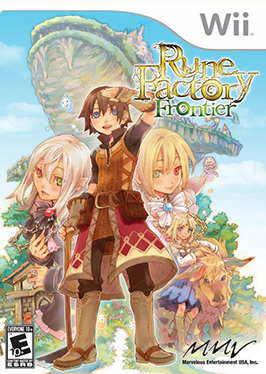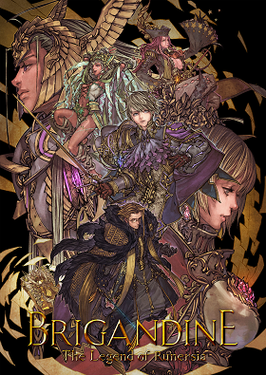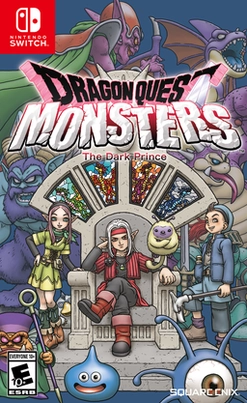The Mana series, known in Japan as Seiken Densetsu, is a high fantasy action role-playing game series created by Koichi Ishii, with development formerly from Square, and is currently owned by Square Enix. The series began in 1991 as Final Fantasy Adventure, a Game Boy handheld side story to Square's flagship franchise Final Fantasy. The Final Fantasy elements were subsequently dropped starting with the second installment, Secret of Mana, in order to become its own series. It has grown to include games of various genres within the fictional world of Mana, with recurring stories involving a world tree, its associated holy sword, and the fight against forces that would steal their power. Several character designs, creatures, and musical themes reappear frequently.
Story of Seasons, known in Japan as Bokujō Monogatari and formerly known as Harvest Moon, is an agricultural farming life simulation video game series created by Yasuhiro Wada and developed by Victor Interactive Software. Story of Seasons was the first game to be released under the new international series title of the same name.

Harvest Moon: A Wonderful Life is a video game that was released in Japan in September 2003 and March 2004 in North America for the GameCube. It was developed and published by Marvelous Interactive, and is part of the long-running Story of Seasons series of video games. The GameCube version offers connectivity with the Game Boy Advance game, Harvest Moon: Friends of Mineral Town.
Marvelous USA Inc., officially doing business as Xseed Games, is an American video game company founded by former members of Square Enix USA. The company is currently a subsidiary of the Japanese game company Marvelous, providing the localization and publishing services for video games and related materials.
Neverland Company Inc. was a Japanese video game developer founded on May 7, 1993. It has developed games for Super NES, Dreamcast, GameCube, PlayStation 2, Game Boy Color, Nintendo DS, Nintendo 3DS, PlayStation Portable, PlayStation 3 and the Wii. The most notable games this company developed were part of the Lufia and Rune Factory series of video games. By November 2013, the company ceased operations and filed for bankruptcy. The following year, many former members of the studio were hired by Marvelous, who had published many of their previous games.

Rune Factory: A Fantasy Harvest Moon is a simulation role-playing video game developed by Neverland and published by Marvelous Interactive Inc., Natsume Inc., and Rising Star Games for the Nintendo DS handheld video game console.
Rune Factory is a franchise of fantasy role-playing social simulation games created by Yoshifumi Hashimoto and primarily published by Marvelous. The games are developed by Hashimoto's studio Hakama, taking over from Neverland after they ceased operations in 2013. The series began as a spin-off to Marvelous' flagship franchise Story of Seasons. The Story of Seasons references were subsequently dropped starting with the second installment, in order to become its own series. With the first game published in 2006, the property consists of five main-series games, two spin-off titles and numerous manga adaptations.
Minako Iwasaki is a Japanese game character designer and manga artist. She joined the game company Nihon Falcom in 1993. After she turned freelance, she took on illustrations of light novels and character designs for the Rune Factory series.

Rune Factory 2: A Fantasy Harvest Moon is a simulation role-playing video game developed by Neverland. It was published in Japan, North America, and Europe by Marvelous Entertainment, Natsume Inc. and Rising Star Games respectively for the Nintendo DS.

Rune Factory: Frontier is a simulation action role-playing video game developed by Neverland and published by Marvelous Entertainment in Japan, Xseed Games in North America, and Rising Star Games in Europe for the Wii. It is the third game in the Rune Factory series.

Rune Factory: Tides of Destiny, known in Japan and PAL regions as Rune Factory: Oceans, is a Wii and PlayStation 3 role-playing game in the Rune Factory series, developed by Neverland. It is published by Marvelous Entertainment in Japan, Natsume Inc. in North America, and Rising Star Games in Europe and Australia.

Rune Factory 4 is a role-playing video game developed by Neverland and published by Marvelous AQL for the Nintendo 3DS. It is the sixth game in the Rune Factory series, and the first to be released on the 3DS. It was released in Japan in July 2012, in North America in October 2013, and in PAL regions in December 2014. An enhanced version, Rune Factory 4 Special, was released for the Nintendo Switch in Japan in July 2019 and worldwide in February 2020. It was also released for the PlayStation 4, Xbox One, and Windows in 2021.

The Japanese video game magazine Famitsu reviews video games by having four critics each assign the game a score from 0 to 10, with 10 being the highest score. The scores of are then added together for a maximum possible score of 40. As of 2024, thirty games have received perfect scores from Famitsu.

God Eater 3 is an action role-playing game developed by Bandai Namco Studios and Marvelous and published by Bandai Namco Entertainment. The third main entry in the God Eater series, the game was released for PlayStation 4 in Japan in December 2018, and worldwide in February 2019 for PlayStation and Microsoft Windows, with a Nintendo Switch version released in July 2019.

Rune Factory 5 is a role-playing simulation video game by Marvelous. The first entry in the Rune Factory series since 2012's Rune Factory 4, it was released for the Nintendo Switch in Japan in May 2021 and in North America and Europe in March 2022, including a Windows port.

Oninaki is a 2019 action role-playing game developed by Tokyo RPG Factory and published by Square Enix for PlayStation 4, Windows and Nintendo Switch. Gameplay has players exploring dungeon areas selected from a world map, fighting enemies in real-time combat with spirit weapons called Daemons while shifting between the worlds of the living and the dead. Oninaki is set in a world where the doctrine of reincarnation is enforced by figures called Watchers, who assist in the passing of souls and fight monsters born of regret. The player controls the Watcher Kagachi as he confronts a shrouded figure called the Night Devil, uncovering hidden truths surrounding the cycle of reincarnation and his own past life.

Brigandine: The Legend of Runersia is a turn-based strategy game with tactical role-playing elements, developed by Matrix Software and published by Happinet. It is a sequel to the 1998 PlayStation game Brigandine: The Legend of Forsena, and features the same core gameplay with a new setting. The player chooses one of six nations of the continent of Runersia and must guide it to conquer the others and unify the land using powerful Rune Knights and their summoned monsters. The game was released worldwide for Nintendo Switch and PlayStation 4 in 2020, and for Windows in May 2022.

Dragon Quest Monsters: The Dark Prince is a 2023 role-playing video game developed by Tose and published by Square Enix. It is the seventh game in the Dragon Quest Monsters series following Dragon Quest Monsters: Joker 3 and the first to be released outside of Japan since Joker 2 in 2011. The Dark Prince was released for the Nintendo Switch in December 2023 and will be released for Android, iOS, and Windows in September 2024. The game received mixed reviews from critics and sold a million copies by January 2024. It is the last Dragon Quest game to be released during Akira Toriyama's lifetime.












